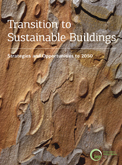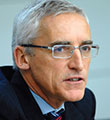27 June 2013
View Webinar Content
Transcript—Webinar audio transcript
The Clean Energy Solutions Center, in partnership with the International Energy Agency, is offering an upcoming webinar to disseminate the findings from IEA’s new publication Transition to Sustainable Buildings: Strategies and Opportunities to 2050, which looks at the role of technologies and policies to transform the way energy is used in the buildings sector.
Buildings are the largest energy-consuming sector in the world, and account for over one-third of total final energy consumption and an equally important source of carbon dioxide (CO2) emissions. Achieving significant energy and emissions reduction in the buildings sector is a challenging but achievable policy goal.
 Transition to Sustainable Buildings presents detailed scenarios and strategies to 2050, and demonstrates how to reach deep energy and emissions reduction through a combination of best available technologies and intelligent public policy. This IEA study is an indispensable guide for decision makers, providing informative insights on:
Transition to Sustainable Buildings presents detailed scenarios and strategies to 2050, and demonstrates how to reach deep energy and emissions reduction through a combination of best available technologies and intelligent public policy. This IEA study is an indispensable guide for decision makers, providing informative insights on:
- Cost-effective options, key technologies and opportunities in the buildings sector
- Solutions for reducing electricity demand growth and flattening peak demand
- Effective energy efficiency policies and lessons learned from different countries
- Future trends and priorities for ASEAN, Brazil, China, the European Union, India, Mexico, Russia, South Africa and the United States
- Implementing a systems approach using innovative products in a cost effective manner
- Pursuing whole-building (e.g. zero energy buildings) and advanced-component policies to initiate a fundamental shift in the way energy is consumed.
Panelists
 Didier Houssin
Didier Houssin
Didier Houssin became Director of Sustainable Energy Policy and Technology at the International Energy Agency on 1 December 2012. Previously, he served for five years as Director of Energy Markets and Security. Before joining the International Energy Agency, Mr. Houssin, a French national, was Managing Director of BRGM, the French Geological Survey where, since 2004, he had extensive management responsibilities over the 850-strong group. Among other matters, he was involved at BRGM in carbon capture and sequestration and in geothermal energy. Prior to joining BRGM, Mr. Houssin was the former Director of Energy and Mineral Resources in the French Ministry of Economy between 1997 and 2004. Mr. Houssin graduated from the Ecole Nationale d’Administration and has a Masters in International Law.
 Marc LaFrance
Marc LaFrance
Marc LaFrance is working in the Energy Demand Technology Unit of the International Energy Agency’s (IEA’s) Sustainable Policy and Technology Directorate on analysis related to buildings. Prior to serving at the IEA, Mr. LaFrance managed a Building R&D program at the US Department of Energy (DOE) focusing on the next generation of technologies that will contribute to achieving zero energy buildings. His projects won four 100 R&D Awards. He also served at Asia Pacific Energy Research Centre in Tokyo working on macro energy and economic analyses for the APEC region. Prior work at the US DOE included the voluntary ENERGY STAR and mandatory minimum efficiency standards programs. Mr. LaFrance has a BS Degree in Mechanical Engineering and a MS Degree in Urban Systems Engineering.
